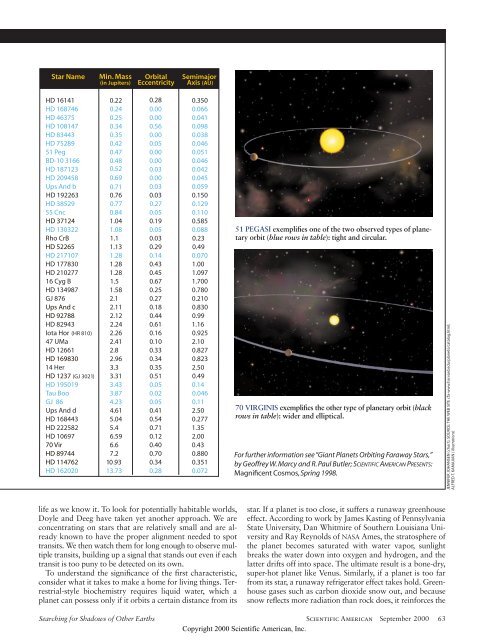Searching for Shadows of Other Earths
Searching for Shadows of Other Earths
Searching for Shadows of Other Earths
You also want an ePaper? Increase the reach of your titles
YUMPU automatically turns print PDFs into web optimized ePapers that Google loves.
Star Name<br />
Star Name<br />
Min. Mass<br />
(in Jupiters)<br />
Orbital<br />
Eccentricity<br />
Semimajor<br />
Axis (AU)<br />
HD 16141<br />
HD 168746<br />
HD 46375<br />
HD 108147<br />
HD 83443<br />
HD 75289<br />
51 Peg<br />
BD-10 3166<br />
HD 187123<br />
HD 209458<br />
Ups And b<br />
HD 192263<br />
HD 38529<br />
55 Cnc<br />
HD 37124<br />
HD 130322<br />
Rho CrB<br />
HD 52265<br />
HD 217107<br />
HD 177830<br />
HD 210277<br />
16 Cyg B<br />
HD 134987<br />
GJ 876<br />
Ups And c<br />
HD 92788<br />
HD 82943<br />
Iota Hor (HR 810)<br />
47 UMa<br />
HD 12661<br />
HD 169830<br />
14 Her<br />
HD 1237 (GJ 3021)<br />
HD 195019<br />
Tau Boo<br />
GJ 86<br />
Ups And d<br />
HD 168443<br />
HD 222582<br />
HD 10697<br />
70 Vir<br />
HD 89744<br />
HD 114762<br />
HD 162020<br />
0.22 0.28<br />
0.350<br />
0.24 0.00<br />
0.066<br />
0.25 0.00<br />
0.041<br />
0.34 0.56<br />
0.098<br />
0.35 0.00<br />
0.038<br />
0.42 0.05<br />
0.046<br />
0.47 0.00<br />
0.051<br />
0.48 0.00<br />
0.046<br />
0.52 0.03<br />
0.042<br />
0.69 0.00<br />
0.045<br />
0.71 0.03<br />
0.059<br />
0.76 0.03<br />
0.150<br />
0.77 0.27<br />
0.129<br />
0.84 0.05<br />
0.110<br />
1.04 0.19<br />
0.585<br />
1.08 0.05<br />
0.088<br />
1.1<br />
0.03<br />
0.23<br />
1.13 0.29<br />
0.49<br />
1.28 0.14<br />
0.070<br />
1.28 0.43<br />
1.00<br />
1.28 0.45<br />
1.097<br />
1.5<br />
0.67<br />
1.700<br />
1.58 0.25<br />
0.780<br />
2.1<br />
0.27<br />
0.210<br />
2.11 0.18<br />
0.830<br />
2.12 0.44<br />
0.99<br />
2.24 0.61<br />
1.16<br />
2.26 0.16<br />
0.925<br />
2.41 0.10<br />
2.10<br />
2.8<br />
0.33<br />
0.827<br />
2.96 0.34<br />
0.823<br />
3.3<br />
0.35<br />
2.50<br />
3.31 0.51<br />
0.49<br />
3.43 0.05<br />
0.14<br />
3.87 0.02<br />
0.046<br />
4.23 0.05<br />
0.11<br />
4.61 0.41<br />
2.50<br />
5.04 0.54<br />
0.277<br />
5.4<br />
0.71<br />
1.35<br />
6.59 0.12<br />
2.00<br />
6.6<br />
0.40<br />
0.43<br />
7.2<br />
0.70<br />
0.880<br />
10 .93 0.34<br />
0.351<br />
13.73 0.28<br />
0.072<br />
51 PEGASI exemplifies one <strong>of</strong> the two observed types <strong>of</strong> planetary<br />
orbit (blue rows in table): tight and circular.<br />
70 VIRGINIS exemplifies the other type <strong>of</strong> planetary orbit (black<br />
rows in table): wider and elliptical.<br />
For further in<strong>for</strong>mation see “Giant Planets Orbiting Faraway Stars,”<br />
by Ge<strong>of</strong>frey W. Marcy and R. Paul Butler; SCIENTIFIC AMERICAN PRESENTS:<br />
Magnificent Cosmos, Spring 1998.<br />
JENNIFER JOHANSEN ( chart); SOURCE: THE WEB SITE cfa-www.harvard.edu/planets/catalog.html;<br />
ALFRED T. KAMAJIAN ( illustrations)<br />
life as we know it. To look <strong>for</strong> potentially habitable worlds,<br />
Doyle and Deeg have taken yet another approach. We are<br />
concentrating on stars that are relatively small and are already<br />
known to have the proper alignment needed to spot<br />
transits. We then watch them <strong>for</strong> long enough to observe multiple<br />
transits, building up a signal that stands out even if each<br />
transit is too puny to be detected on its own.<br />
To understand the significance <strong>of</strong> the first characteristic,<br />
consider what it takes to make a home <strong>for</strong> living things. Terrestrial-style<br />
biochemistry requires liquid water, which a<br />
planet can possess only if it orbits a certain distance from its<br />
star. If a planet is too close, it suffers a runaway greenhouse<br />
effect. According to work by James Kasting <strong>of</strong> Pennsylvania<br />
State University, Dan Whitmire <strong>of</strong> Southern Louisiana University<br />
and Ray Reynolds <strong>of</strong> NASA Ames, the stratosphere <strong>of</strong><br />
the planet becomes saturated with water vapor, sunlight<br />
breaks the water down into oxygen and hydrogen, and the<br />
latter drifts <strong>of</strong>f into space. The ultimate result is a bone-dry,<br />
super-hot planet like Venus. Similarly, if a planet is too far<br />
from its star, a runaway refrigerator effect takes hold. Greenhouse<br />
gases such as carbon dioxide snow out, and because<br />
snow reflects more radiation than rock does, it rein<strong>for</strong>ces the<br />
<strong>Searching</strong> <strong>for</strong> <strong>Shadows</strong> <strong>of</strong> <strong>Other</strong> <strong>Earths</strong> Scientific American September 2000 63<br />
Copyright 2000 Scientific American, Inc.
















